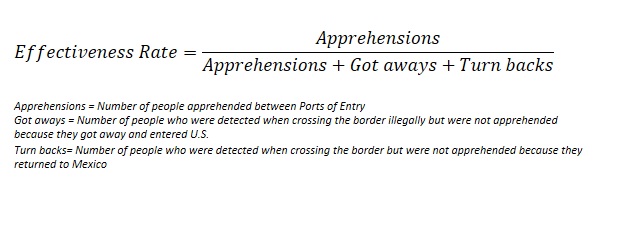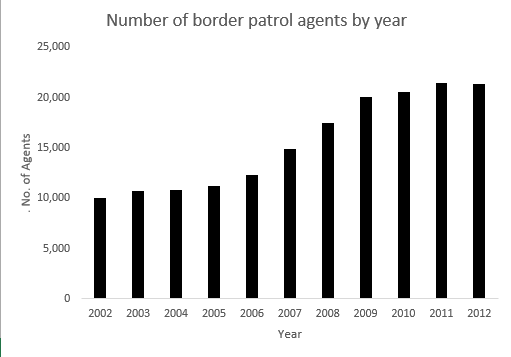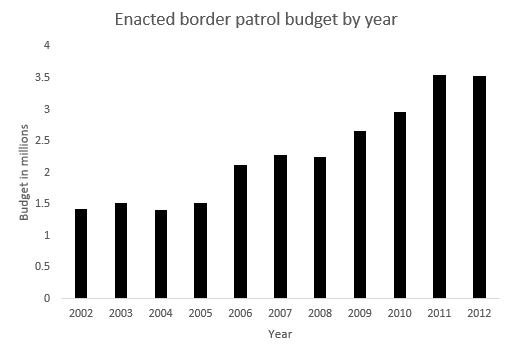
Customs and Border patrol officer’s badge. Source: Bill Morrow on Flickr.com
WASHINGTON — Would you shell out money without knowing what you are paying for? Probably not.
But when it comes to border security, Congress may have been doing just that, according to reports from Government Accountability Office and Congressional Research Service.
The reports issued recently by the two independent research arms of Congress indicate that despite the billions of dollars spent on border security measures and the tables of data collected by the Department of Homeland Security, there is no robust metric to measure the effectiveness of the enforcement efforts.
Since 2011, DHS has used the number of apprehensions of illegal entrants on the Southwest border as a measure of effectiveness. Before 2011, the main measure was the number of miles of the southern border that was secured. Experts agree that both are inadequate metrics.
“Apprehensions provide information only on activity levels,” said Rebecca Gambler, GAO’s director of homeland security and justice issues and the author of the GAO report. “It cannot be used to inform resource allocation or to measure the success of the efforts.”
In the CRS report, Marc Rosenblum expressed a similar view. “We do not know if a decline in apprehensions is a good thing because fewer people are attempting to enter or a bad thing because more of them are succeeding,” he wrote.
The Office of Customs and Border Protection appears to be grappling with the same question. In 2009, CBP attributed increases in apprehensions in certain sectors to improved operations, while they explained away drops in the same metric as outcome of the deterrent effects of the improved technology.
Andrew Morral, a senior behavioral scientist at RAND Corporation said a metric that “indicates success whether it rises or falls has limited value as a management tool.” RAND Corporation, a nonprofit research organization, has worked with DHS in ascertaining challenges in creating a performance metric for border security.
According to GAO reports, DHS is expected to come up with a plan to establish goals and milestone by end of the year.
Inconsistency in data collection in each sector of the border and the inability to account with enough certainty the number of people who cross undetected are other problems that plague the already weak metric, the GAO and CRS reports said.
Not having a yardstick to measure the effectiveness of the existing measures has not stopped the government from pumping in more money and resources into border security. The number of border patrol agents doubled from nearly 10,000 in 2004 to 21,394 in 2012. In the same time period, there was a 370 percent increase in the miles of fence on the southern border.
The Senate immigration bill proposal, which was rejected by the House, had provisions to allocate an additional $46 billion to securing the border while doubling the number of patrol agents.
Additional investment without further research may yield diminishing results, Morral said. “We have invested a lot of money and have already hit the low hanging fruit,” he said. “Extending this to cover the entire southern border is not something we can justify.”
Christopher Wilson, an associate at the Woodrow Wilson International Center for Scholars, criticized the bill’s more boots-on-the-ground approach.
“If you look at the data, you can see that each agent makes only 3.5 apprehensions annually,” he said. “By adding more people, we are essentially paying someone to just drive around.”
Estimating the flow of people and goods across the border is a complex problem. “We are talking about measuring illicit activity, which by definition is hidden,” Wilson said.
Scientists and researchers like Morral and Rosenblum have recommended other methodologies that will yield a clearer picture of the flow of goods and people across the border.
Scientists said complex mathematical models that take into consideration various direct and indirect factors – including the coyote market, the amount of money people spend on illicit drugs in the U.S. and the number of repeat offenders apprehended at the border – may be required to estimate the flow across the border with a fair level of accuracy.
Meanwhile, DHS has been working on a metric called the Border Condition Index or BCI, details of which are not public.
But a scientist at DHS;s center for funding research said that BCI is not a measure of security but a more holistic view of the border condition, as its name suggests.
The scientist declined to comment on the data points that make up the index. But he said that BCI, by itself, will not be an effective way to drive resource allocation.



